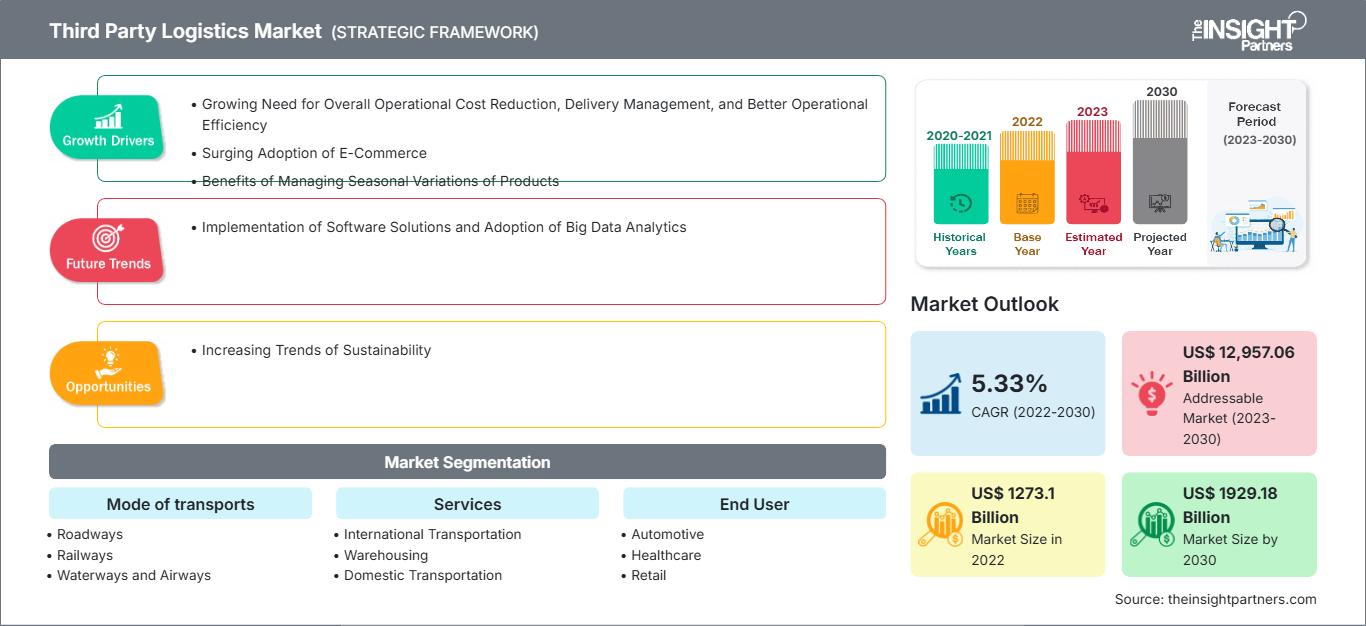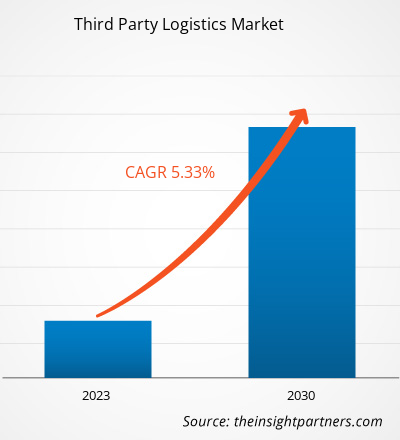제3자 물류 시장은 2022년 1조 2,731억 달러 규모였으며, 2030년에는 1조 9,291억 8천만 달러에 이를 것으로 예상됩니다. 2022년부터 2030년까지 연평균 성장률 5.33%를 기록할 것으로 예상됩니다.
전자상거래의 급속한 확산은 시장의 주요 트렌드로 남을 것으로 예상됩니다.
제3자 물류 시장 분석
전자상거래의 성장과 당일 또는 익일 배송에 대한 수요 증가는 라스트 마일 배송 서비스에 대한 수요를 촉진합니다. 예를 들어, 아마존 프라임 서비스는 빠른 배송에 대한 새로운 기준을 제시했으며, 3PL 업체들은 이러한 기대에 부응하기 위해 서비스를 개선하고 있습니다. 환경 문제와 지속가능성에 대한 인식이 높아짐에 따라 친환경 물류 솔루션에 대한 수요도 증가했습니다. 3PL 업체들은 전기차를 도입하고, 배출가스 감축을 위한 경로를 최적화하며, 소비자 및 규제 기관의 기대에 부응하는 지속 가능한 포장 관행을 시행하고 있습니다.
제3자 물류 시장 개요
공장에서 창고로의 제조 상품 운송은 전체 3PL 프로세스의 첫 단계입니다. 3PL 업체는 제품이 창고 또는 물류 센터에 도착하면 보관합니다. 제품은 SKU(재고 관리 단위)에 따라 보관되며, 각 SKU에는 자체 보관 장소가 할당됩니다. 창고에 입고되는 품목은 일반적으로 이 시점에서 공급업체의 추적 시스템에 입력됩니다. 소프트웨어 통합은 효율적이고 효과적인 프로세스를 구축하는 데 도움이 됩니다.
요구 사항에 맞게 이 보고서를 사용자 정의하십시오.
이 보고서의 일부, 국가 수준 분석, Excel 데이터 팩을 포함하여 모든 보고서에 대한 사용자 정의를 무료로 받을 수 있을 뿐만 아니라 스타트업 및 대학을 위한 훌륭한 제안 및 할인을 이용할 수 있습니다
제3자 물류 시장: 전략적 통찰력

-
이 보고서의 주요 주요 시장 동향을 확인하세요.이 무료 샘플에는 시장 동향부터 추정 및 예측에 이르기까지 데이터 분석이 포함됩니다.
제3자 물류 기업은 주요 기업의 효율적인 확장을 지원하는 자원 네트워크를 확장하여 비용 효율적인 방식으로 성장해 왔습니다. 또한, 제3자 물류 기업은 계절별 재고 또는 신제품 출시에 필요한 충분한 자원과 탄력적인 서비스를 제공할 수 있습니다. 많은 기업이 고객 성향의 계절적 변동을 경험하며, 효율성을 유지하고 수요를 충족하기 위해서는 이러한 변동을 관리하는 것이 중요합니다.
소프트웨어 솔루션 적용 및 빅데이터 분석 도입
RFID 지원 장치의 도입은 간편한 운송을 위한 데이터 저장을 통해 제품 추적 및 식별을 간소화할 것으로 예상됩니다. 운송 관리 시스템 관련 소프트웨어는 비효율성과 비용을 줄여줄 것입니다. 또한, 창고 관리 시스템 통신에 음성 인식 소프트웨어를 활용하면 주문 처리 및 재고 기록에 도움이 되는 동시에 직원 교육 필요성을 줄일 수 있습니다. 이와 함께, 제3자 물류 기관에서 클라우드 기반 기술을 도입함으로써 고객 접근성에 대한 필요성을 인식하고 계절별 추세에 더욱 효과적으로 대응할 수 있게 되어 수요에 부응할 것입니다.
제3자 물류 시장 보고서 세분화 분석
제3자 물류 시장 분석 도출에 기여한 주요 부문은 운송 수단, 서비스, 최종 사용자입니다.
- 운송 수단에 따라 제3자 물류 시장은 도로, 철도, 수로, 항공으로 구분됩니다. 도로 부문은 2023년에 더 큰 시장 점유율을 기록했습니다.
- 서비스에 따라 제3자 물류 시장은 국제 운송, 창고, 국내 운송, 재고 관리 등으로 구분됩니다. 국내 운송 부문은 2023년에 더 큰 시장 점유율을 기록했습니다.
- 최종 사용자에 따라 제3자 물류 시장은 자동차, 의료, 소매, 소비재 등으로 구분됩니다. 기타 부문은 2023년에 더 큰 시장 점유율을 차지했습니다.
지역별 제3자 물류 시장 점유율 분석
제3자 물류 시장 보고서의 지리적 범위는 주로 북미, 아시아 태평양, 유럽, 중동 및 아프리카, 남미 및 중미의 5개 지역으로 나뉩니다.
제3자 물류 시장 보고서의 범위는 북미(미국, 캐나다 및 멕시코), 유럽(러시아, 영국, 프랑스, 독일, 이탈리아 및 기타 유럽), 아시아 태평양(한국, 인도, 호주, 일본, 중국 및 기타 아시아 태평양), 중동 및 아프리카(사우디 아라비아, 남아프리카, UAE 및 기타 중동 및 아프리카), 남미 및 중미(아르헨티나, 브라질 및 기타 남미 및 중미)를 포함합니다. 매출 측면에서 아시아 태평양 지역은 2023년 제3자 물류 시장 점유율에서 우위를 차지했습니다. 유럽은 글로벌 제3자 물류 시장에 두 번째로 큰 기여를 하고 있으며, 그 뒤를 북미가 잇고 있습니다.
제3자 물류 시장 지역별 통찰력
The Insight Partners의 분석가들은 예측 기간 동안 제3자 물류 시장에 영향을 미치는 지역별 동향과 요인들을 면밀히 분석했습니다. 이 섹션에서는 북미, 유럽, 아시아 태평양, 중동 및 아프리카, 그리고 중남미 지역의 제3자 물류 시장 부문 및 지역별 현황도 살펴봅니다.
제3자 물류 시장 보고서 범위
| 보고서 속성 | 세부 |
|---|---|
| 시장 규모 2022 | US$ 1273.1 Billion |
| 시장규모별 2030 | US$ 1929.18 Billion |
| 글로벌 CAGR (2022 - 2030) | 5.33% |
| 이전 데이터 | 2020-2021 |
| 예측 기간 | 2023-2030 |
| 다루는 세그먼트 |
By 운송 수단
|
| 포함된 지역 및 국가 |
북미
|
| 시장 선도 기업 및 주요 회사 프로필 |
|
제3자 물류 시장 참여자 밀도: 비즈니스 역학에 미치는 영향 이해
제3자 물류 시장은 소비자 선호도 변화, 기술 발전, 그리고 제품 이점에 대한 인식 제고 등의 요인으로 인한 최종 사용자 수요 증가에 힘입어 빠르게 성장하고 있습니다. 수요가 증가함에 따라 기업들은 제품 및 서비스를 확장하고, 소비자 니즈를 충족하기 위한 혁신을 추진하며, 새로운 트렌드를 적극 활용하고 있으며, 이는 시장 성장을 더욱 가속화하고 있습니다.

- 을 얻으세요 제3자 물류 시장 주요 주요 플레이어 개요
제3자 물류 시장은 1차 및 2차 조사 후 주요 기업 간행물, 협회 데이터, 데이터베이스 등 정성적 및 정량적 데이터를 수집하여 평가합니다. 제3자 물류 시장의 몇 가지 동향은 다음과 같습니다.
- 세계적인 물류 서비스 제공업체 중 하나인 DB Schenker와 선도적인 용량 솔루션 제공업체인 USA Truck은 DB Schenker가 USA Truck의 보통주 전 주식을 주당 31.72달러에 현금으로 인수하는 계약을 체결했습니다. USA Truck은 인수 현금 및 부채를 포함하여 약 4억 3,500만 달러의 거래 비용을 지불했습니다. (출처: DB Schenker, 보도자료, 2022년 7월)
- 세계적인 물류 기업인 도이체 포스트 DHL 그룹(Deutsche Post DHL Group)은 오늘 2023년 7월 1일부터 회사명을 "DHL 그룹"으로 변경한다고 발표했습니다. 새 이름은 지난 몇 년간 그룹이 겪은 변화를 반영하며, 미래 성장 동력으로서 국내 및 국제 물류 활동에 집중해 온 것을 기념하는 것입니다. (출처: DHL 그룹, 보도자료, 2023년 7월)
제3자 물류 시장 보고서 범위 및 결과
“제3자 물류 시장 규모 및 예측(2020~2030)” 보고서는 다음 영역을 포괄하는 시장에 대한 자세한 분석을 제공합니다.
- 범위에 포함된 모든 주요 시장 부문에 대한 글로벌, 지역 및 국가 수준의 제3자 물류 시장 규모 및 예측
- 제3자 물류 시장 동향 및 추진 요인, 제약 및 주요 기회와 같은 시장 역학
- 자세한 PEST 및 SWOT 분석
- 주요 시장 동향, 글로벌 및 지역 프레임워크, 주요 업체, 규정 및 최근 시장 개발을 포괄하는 제3자 물류 시장 분석
- 시장 집중도, 히트맵 분석, 주요 업체 및 제3자 물류 시장의 최근 개발을 포괄하는 산업 환경 및 경쟁 분석
- 자세한 회사 프로필
- 과거 분석(2년), 기준 연도, CAGR을 포함한 예측(7년)
- PEST 및 SWOT 분석
- 시장 규모 가치/거래량 - 글로벌, 지역, 국가
- 산업 및 경쟁 환경
- Excel 데이터세트
최근 보고서
관련 보고서
사용 후기
구매 이유
- 정보에 기반한 의사 결정
- 시장 역학 이해
- 경쟁 분석
- 고객 인사이트
- 시장 예측
- 위험 완화
- 전략 기획
- 투자 타당성 분석
- 신흥 시장 파악
- 마케팅 전략 강화
- 운영 효율성 향상
- 규제 동향에 발맞춰 대응






















 무료 샘플 받기 - 제3자 물류 시장
무료 샘플 받기 - 제3자 물류 시장